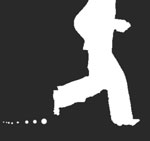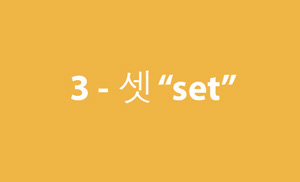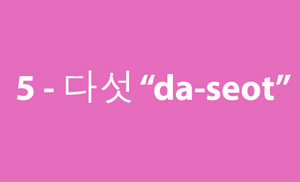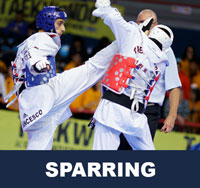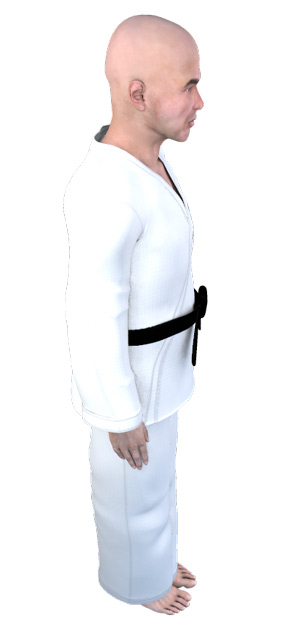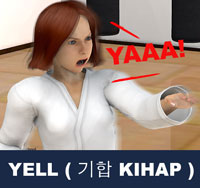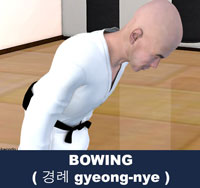Taekwondo 태권도Taekwondo Preschool
When you reach senior belt you are expected to guide the junior belts when they are beginning Taekwondo such as showing by example. To advance from one rank to the next, students typically complete promotion tests in which they demonstrate their proficiency in the various aspects of the art before a panel of judges or their teacher. View Taekwondo belt levels »
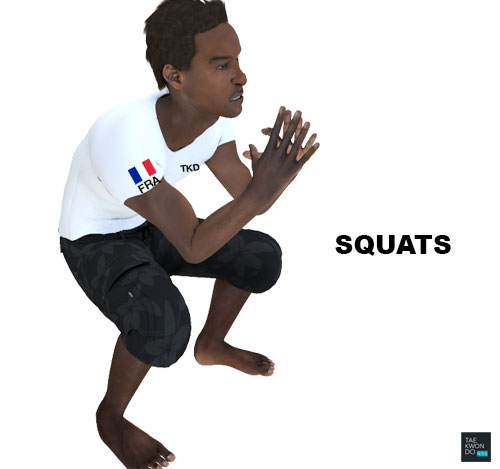
About Squats
The risks and benefits of combining stretching with warming up are disputed, although it is generally believed that warming up prepares the athlete both mentally and physically.
* Please see a certified Master Instructor ( 사범님 sabeomnim ) for training. Proper guidance and instructions are needed to ensure safe training.
In strength training, the squat is a compound, full body exercise that trains primarily the muscles of the thighs, hips and buttocks, quads (vastus lateralus medialis and intermedius), hamstrings, as well as strengthening the bones, ligaments and insertion of the tendons throughout the lower body. Squats are considered a vital exercise for increasing the strength and size of the legs and buttocks, as well as developing core strength. Isometrically, the lower back, the upper back, the abdominals, the trunk muscles, the costal muscles, and the shoulders and arms are all essential to the exercise and thus are trained when squatting with the proper form.
Form
The movement begins from a standing position. The movement is initiated by moving the hips back and bending the knees and hips to lower the torso, then returning to the upright position.
As the body gradually descends, the hips and knees undergo flexion, the ankle dorsiflexes and muscles around the joint contract eccentrically, reaching maximal contraction at the bottom of the movement while slowing and reversing descent. The muscles around the hips provide the power out of the bottom. If the knees slide forward or cave in then tension is taken from the hamstrings, hindering power on the ascent. Returning to vertical contracts the muscles concentrically, and the hips and knees undergo extension while the ankle plantar flexes. In a weight bearing squat, the heels should always maintain contact with the floor throughout the movement. Weight shifting forward on to the toes, and off the heels creates unnecessary stress on the knee joint. This added stress may lead to inflammation or other overuse injuries.
Plyometric / Bodyweight
- Bodyweight squat – done with no weight or barbell, often at higher repetitions than other variants.
- Overhead squat – a non-weight bearing variation of the squat exercise, with the hands facing each other overhead, biceps aligned with the ears, and feet hip-width apart. This exercise is a predictor of total-body flexibility, mobility, and possible lower body dysfunction.
- Face the wall squat – performed with or without weights. It is primarily to strengthen the vertebrae tissues. In the Chinese variant weights are not used. Toes, knees and nose line up almost touching the wall. Advanced forms include shoeless, wrists crossed behind the back, and fists in front of forehead, all performed with toes and knees closed and touching the wall.
- Hindu squat – done without weight where the heels are raised and body weight is placed on the toes; the knees track far past the toes.
- Jump squat – a plyometrics exercise where the squatter engages in a rapid eccentric contraction and jumps forcefully off the floor at the top of the range of motion.
- Pistol or pistol squat – a bodyweight squat done on one leg to full depth, while the other leg is extended off the floor. Sometimes dumbbells, kettlebells or medicine balls are added for resistance. (aka single leg squat).
Injury Considerations
Although the squat has long been a basic element of weight training, it has in recent years been the subject of considerable controversy. Some trainers allege that squats are associated with injuries to the lumbar spine and knees. Others, however, continue to advocate the squat as one of the best exercises for building muscle and strength. Some coaches maintain that incomplete squats (those terminating above parallel) are both less effective and more likely to cause injury than a full squat (terminating with hips at or below knee level).
Difficulty of Warm-Up Exercise
The risks and benefits of combining stretching with warming up are disputed, although it is generally believed that warming up prepares the athlete both mentally and physically. The more difficult the warm-up, the more practice may be needed for the purpose of improving or mastering it, as in the phrase 'practice makes perfect'.
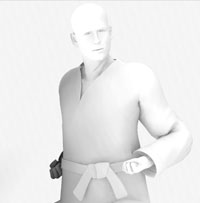
Training Safety Precautions
Overtraining can be described as a point where a person may have a decrease in performance and plateauing as a result from failure to consistently perform at a certain level or training load exceeds their recovery capacity. They cease making progress, and can even begin to lose strength and fitness. Overtraining is also known as chronic fatigue, burnout and overstress in athletes.
It is important to note the difference between overtraining and over-reaching; over-reaching is when an athlete is undergoing hard training but with adequate recovery, overtraining however, is when an athlete is undergoing hard training without the adequate recovery. View Overtraining »
* Please see a certified Master Instructor ( 사범님 sabeomnim ) for training. Proper guidance and instructions are needed to ensure safe training.
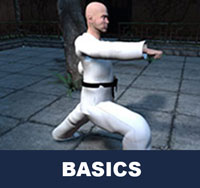
Taekwondo Basics
Here is where you can learn more about Taekwondo 태권도. Knowing the fundamental basics is very important for your learning path as you build your skills and knowledge. There are certain rules that need to be followed to show respect to the master ( 사범님 sabeomnim ), the instructors ( 교사님 gyosannim ), other practitioners and to the martial arts. They vary between schools but many have similar rules and guidelines. For more information View Taekwondo Basics »
Please follow the guidance of a certified Master Instructor or trainer when doing sports related activities. The article provided on this page is information that is widely available on Wikipedia article "Squat (exercise)". Risk of injury can be reduced by completing an effective warm up consisting of a heart raiser to get your pulse up, followed by sport specific dynamic stretches (stretches whilst moving).
There are five tenets defined in the International Taekwondo Federation (ITF) and several more in World Taekwondo (WT).
Integrity ( 염치 yeom-chi ): "Although it may be similar, this form of integrity takes on a more wider role then defined in the common dictionary. In taekwondo, integrity means not only to determine what is right or wrong but also having the conscience to feel guilt if one has done wrong and to have the integrity stand up for what is right." View Taekwondo Tenets »
RESOURCES
This article uses material from the Wikipedia article "Squat (exercise)", which is released under the Creative Commons Attribution-Share-Alike License 3.0.


